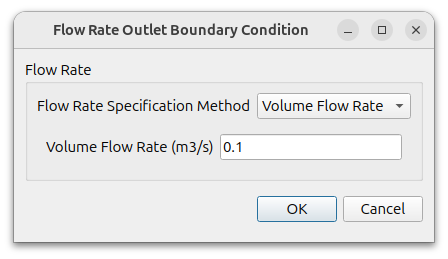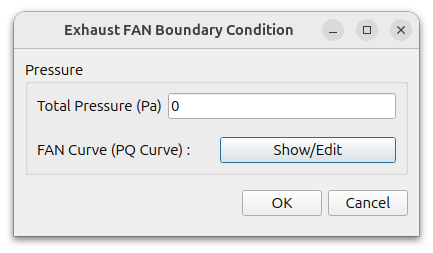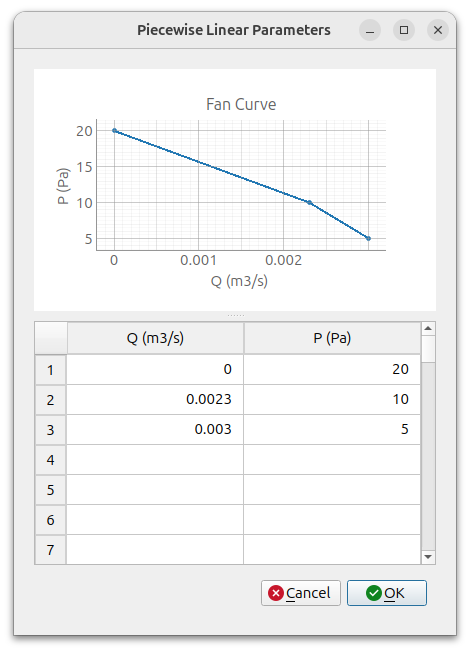Outlet Boundary Conditions
The types of outlet boundary conditions include
- Pressure Outlet
- Flow Rate Outlet
- Exhaust Fan
- Open Channel Outlet
- Outflow
- Subsonic Outflow
- Supersonic Outflow
Pressure Outlet
Pressure Outlet is a condition that applies a constant pressure to the outlet boundary. The pressure is used as static pressure for outflow while it is used as total pressure for backflow.

Enter a pressure and select two options – ‘Non-Reflecting Boundary’ and ‘Specify Backflow Properties’
When no options are used, the boundary conditions in openfoam used by each field are as follows
- Velocity : pressureInletOutletVelocity
- Pressure : totalPressure (This condition use total pressure for inflow condition, and use static pressure for outflow condition.)
- Temperature : zeroGradient
- Turbulence : zeroGradient
- Species : zeroGradient
Specify Backflow Properties option
The Specify Backflow Properties option allows you to specify the total temperature and turbulence conditions of the flow entering the computational domain.
With this option, the boundary conditions used by openfoam for the temperature, turbulence field, and chemical species are as follows
- Temperature : inletOutletTotalTemperature
- Turbulent kinetic energy(k) : turbulentIntensityInletOutletTKE
- Turbulent dissipation rate($\epsilon$), specific dissipation rate($\omega$) : viscosityRatioInletOutletTDR
- Modified kinematic viscosity($\tilde{\nu}$) : inletOutlet
- Species : inletOutlet
Non-Reflecting Boundary option
This is a condition where pressure waves are not reflected at the boundary. It can be used when energy equation is On, the density is a perfect gas and the specific heat capacity is constant.
We use openfoam’s waveTransmissive boundary condition for velocity and pressure, and the rest of the fields are the same as without the option.
Non-Reflecting Boundary tutorial : subsonic cavity flow
Flow Rate Outlet
Flow rate conditions are applied at the outlet.
Flow rate can be expressed as mass flow rate or volume flow rate.

The boundary condition used by the velocity (U) in OpenFOAM is flowRateIneltVelocity, while pressure, turbulence, and temperature are zeroGradient.
Exhaust Fan
Use fan conditions at the outlet of the flow. Input the total pressure and fan performance curve.

Clicking the Show/Edit button on the FAN Curve displays a spreadsheet where you can input flow rate and pressure. You can enter values directly or copy and paste columns from spreadsheet programs like Excel. Once the data is entered, the performance curve graph is plotted.

Open Channel Outlet
Open Channel Outlet is a condition that gives the outlet a constant average velocity when calculating the free surface and allows the height of the water surface to vary accordingly.
Open Channel Outlet tutorial : ship resistance

Enter the average velocity as a constant.
The openfoam boundary conditions used by each field are as follows
- Velocity : outletPhaseMeanVelocity
- Pressure : zeroGradient
- Volume fraction : variableHeightFlowRate
- Turbulent kinetic energy(k) : turbulentIntensityInletOutletTKE_
- Turbulent dissipation rate($\epsilon$), specific dissipation rate($\omega$) : viscosityRatioInletOutletTDR
- Modified kinematic viscosity($\tilde{\nu}$) : inletOutlet
Outflow
Outflow uses zero gradient conditions for all fields on the exit.
Subsonic Outflow
Supersonic Outflow is a supersonic outlet boundary condition for a compressible flow.
There is nothing to enter, and the openfoam boundary condition for all fields is zeroGradient.
Supersonic Outflow
Supersonic Outflow is a supersonic outlet boundary condition for a compressible flow.
There is nothing to enter, and the openfoam boundary condition for all fields is zeroGradient.